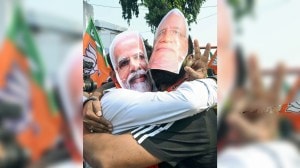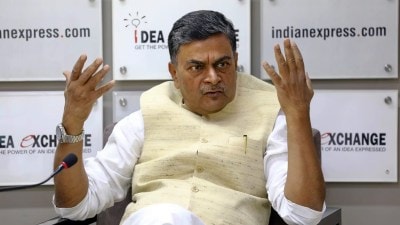Stay updated with the latest - Click here to follow us on Instagram
Bullet train loan rate 0.1%, free in a way: PM Narendra Modi
The Prime Minister said the high speed corridor and other developments in the rail sector like doubling of lines and the Dedicated Freight Corridor were all part of the larger plan for economic growth through robust transport infrastructure.
 Prime Ministers Narendra Modi and Shinzo Abe with (from left) Railways Minister Piyush Goyal, Gujarat Governor O P Kohli, Gujarat Chief Minister Vijay Rupani and Maharashtra Chief Minister Devendra Fadnavis in Ahmedabad on Thursday. (PTI Photo)
Prime Ministers Narendra Modi and Shinzo Abe with (from left) Railways Minister Piyush Goyal, Gujarat Governor O P Kohli, Gujarat Chief Minister Vijay Rupani and Maharashtra Chief Minister Devendra Fadnavis in Ahmedabad on Thursday. (PTI Photo)
“More productivity with high-speed connectivity” is what India will gain from the bullet train, which the country is getting “for free, in a way”, Prime Minister Narendra Modi said on Thursday while inaugurating the start of work on the 508-km project.
With Japanese Prime Minister Shinzo Abe by his side near the site of the proposed Sabarmati station of the Ahmedabad-Mumbai high-speed corridor, Modi said the project was being made possible because of a loan from Japan of Rs 88,000 crore at a 0.1 per cent interest to be repaid over 50 years.
“Yeh bullet train Japan ki Bharat ko bahut bada saugaat hai. Ek prakaar se muft mein yeh pura project banta ja raha hai (This bullet train is a big gift to India from Japan. This entire project is getting built for free, in a way),” Modi said. “In Shinzo Abe, India has found a friend no bank in the world could match,” he said.
Japan is financing 81 per cent of the Rs 1.08 lakh crore project through the Japan International Cooperation Agency.
Read | China in mind, India and Japan agree to deepen strategic ties
“It is my wish that when India celebrates 75 years of Independence in 2022-23, Abe and I together travel in this train,” Modi said, echoing his Japanese counterpart who had said that he would like to visit Gujarat on the bullet train the next time.
At the event, Abe and Modi pressed a button on a remote control device from the dais to unveil the foundation stone, even as a crane and a few workers were shown on screen starting the symbolic ground-breaking at the project site in Vadodara. A staff training centre will also come up at the site.
The high-speed rail project was conceived over 10 years ago on paper, but picked up speed only three years ago after the NDA came to power.
“The next generation economic growth will take place along high speed railways. Our stress is on more productivity with high speed connectivity. This project will not only bring Mumbai and Ahmedabad closer, but the entire stretch can develop as a single economic corridor…The time for slow growth is over,” Modi said.
The bullet train’s official completion date is 2023, which the government is trying to advance by about a year to coincide with 75 years of India’s independence. “If India and Japan decide, I am sure it can be done a year in advance,” Modi said.
The Prime Minister said that the high-speed corridor should be viewed in the context of overall economic development. “Considering the time it takes to reach the airport and then take a flight and ultimately reach the destination in the city, the bullet train will take half the time for people to reach. Think of the time saved, the ‘thousands’ of vehicles that may go off road between Mumbai and Ahmedabad,” Modi said.
Read | India-Japan joint statements: Terror to defence, a gradual shift
As a ripple effect, less cars and buses would mean less consumption of fuel, which in turn means savings in foreign currency to import fuel, he said.
According to officials, the bullet train will take 2.07 hours to cover the distance at a maximum speed of 350 km per hour and four halts. More halts will marginally increase the travel time, but the overall journey time is expected to be capped at around three hours.
Modi also indicated that the fares of the bullet train might be within reach of the common man. “Usually, new technology comes for an elite class of select few. Our aim is to make modern technology affordable for the poor and the common man. Now that we are infusing new, modern technology in Railways, we should ensure that the common man benefits from this new technology,” he said.
The Prime Minister said the high speed corridor and other developments in the rail sector like doubling of lines and the Dedicated Freight Corridor were all part of the larger plan for economic growth through robust transport infrastructure.
“Highways are being built, 106 waterways are being developed for carriage of goods and now, the aviation sector is throwing up new possibilities. In the past three years, the number of domestic fliers has increased by around 3 crore. We now also have a national aviation policy,” he said, adding that post-GST, economic activities have seen a 30 per cent increase.
In his address, Abe said, “My good friend Modiji has taken a decision (to build the bullet train). We have decided to totally support this decision.”
Taking a leaf out of Modi’s style of coming up with acronyms for various government initiatives, Abe said that if you join Japan’s ‘Ja’ and India ‘I’, it becomes “Jai”, or victory in Hindi. “Our friendship with India has developed into a strategic and global partnership,” he said.
Read | Citing Nehru, Japanese PM resolves to be ‘friend of India forever’
Abe said that the Japanese bullet train Shinkansen — the Indian train will be a modern version — brought in economic development in post-World War Japan. “After the World War, Japan had become a land of burnt fields. With the advent of Shinkansen in 1964, distances were bridged… with new jobs, lifestyle and economic activities, and Japan entered 10 per cent-plus GDP growth,” he said.
Abe said that Kawasaki Heavy Industries and India’s BHEL will together manufacture rolling stock for the project. “With Japanese collaboration, India can emerge as the factory of the world,” Abe said.
Railway Minister Piyush Goyal, Gujarat Chief Minister Vijay Rupani and Maharashtra Chief Minister Devendra Fadnavis were present at the event.







